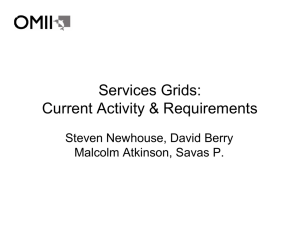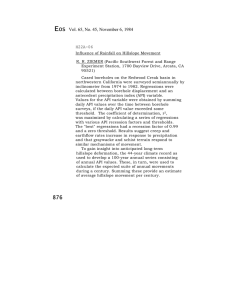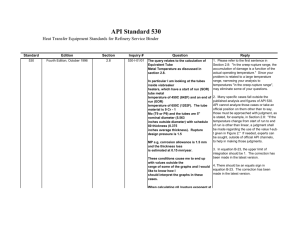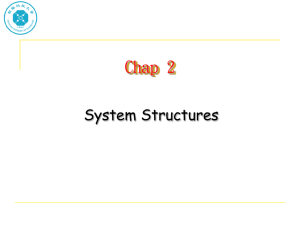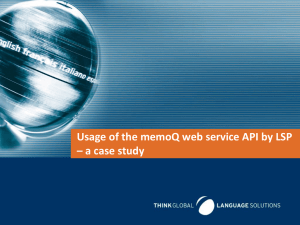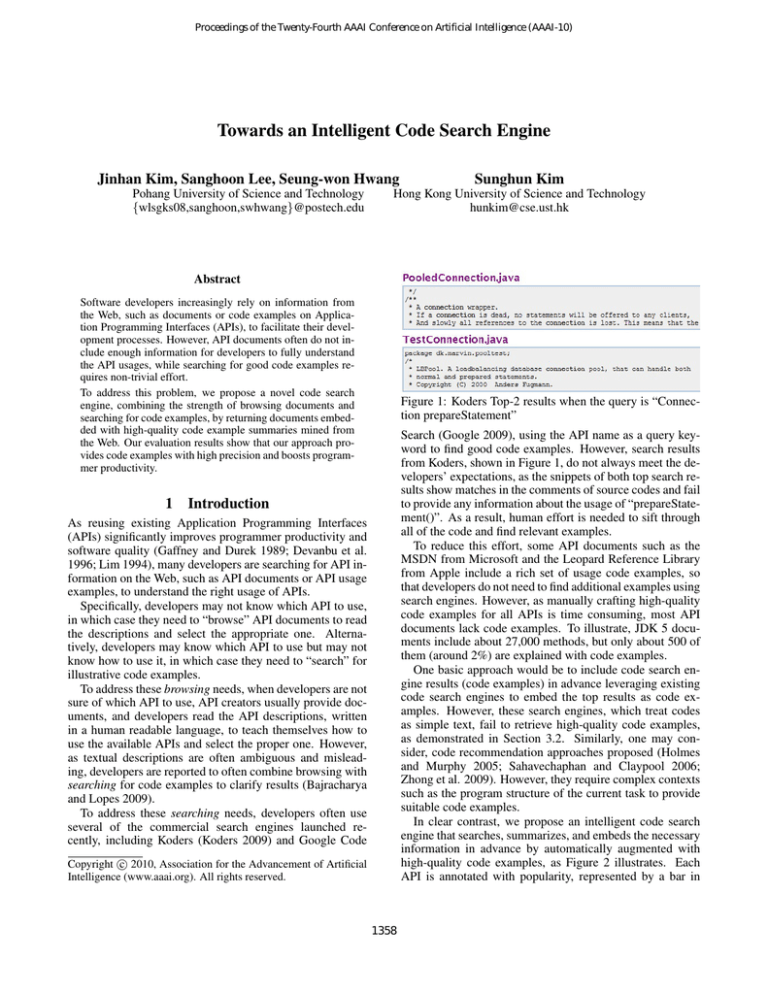
Proceedings of the Twenty-Fourth AAAI Conference on Artificial Intelligence (AAAI-10)
Towards an Intelligent Code Search Engine
Jinhan Kim, Sanghoon Lee, Seung-won Hwang
Pohang University of Science and Technology
{wlsgks08,sanghoon,swhwang}@postech.edu
Sunghun Kim
Hong Kong University of Science and Technology
hunkim@cse.ust.hk
Abstract
Software developers increasingly rely on information from
the Web, such as documents or code examples on Application Programming Interfaces (APIs), to facilitate their development processes. However, API documents often do not include enough information for developers to fully understand
the API usages, while searching for good code examples requires non-trivial effort.
To address this problem, we propose a novel code search
engine, combining the strength of browsing documents and
searching for code examples, by returning documents embedded with high-quality code example summaries mined from
the Web. Our evaluation results show that our approach provides code examples with high precision and boosts programmer productivity.
1
Figure 1: Koders Top-2 results when the query is “Connection prepareStatement”
Search (Google 2009), using the API name as a query keyword to find good code examples. However, search results
from Koders, shown in Figure 1, do not always meet the developers’ expectations, as the snippets of both top search results show matches in the comments of source codes and fail
to provide any information about the usage of “prepareStatement()”. As a result, human effort is needed to sift through
all of the code and find relevant examples.
To reduce this effort, some API documents such as the
MSDN from Microsoft and the Leopard Reference Library
from Apple include a rich set of usage code examples, so
that developers do not need to find additional examples using
search engines. However, as manually crafting high-quality
code examples for all APIs is time consuming, most API
documents lack code examples. To illustrate, JDK 5 documents include about 27,000 methods, but only about 500 of
them (around 2%) are explained with code examples.
One basic approach would be to include code search engine results (code examples) in advance leveraging existing
code search engines to embed the top results as code examples. However, these search engines, which treat codes
as simple text, fail to retrieve high-quality code examples,
as demonstrated in Section 3.2. Similarly, one may consider, code recommendation approaches proposed (Holmes
and Murphy 2005; Sahavechaphan and Claypool 2006;
Zhong et al. 2009). However, they require complex contexts
such as the program structure of the current task to provide
suitable code examples.
In clear contrast, we propose an intelligent code search
engine that searches, summarizes, and embeds the necessary
information in advance by automatically augmented with
high-quality code examples, as Figure 2 illustrates. Each
API is annotated with popularity, represented by a bar in
Introduction
As reusing existing Application Programming Interfaces
(APIs) significantly improves programmer productivity and
software quality (Gaffney and Durek 1989; Devanbu et al.
1996; Lim 1994), many developers are searching for API information on the Web, such as API documents or API usage
examples, to understand the right usage of APIs.
Specifically, developers may not know which API to use,
in which case they need to “browse” API documents to read
the descriptions and select the appropriate one. Alternatively, developers may know which API to use but may not
know how to use it, in which case they need to “search” for
illustrative code examples.
To address these browsing needs, when developers are not
sure of which API to use, API creators usually provide documents, and developers read the API descriptions, written
in a human readable language, to teach themselves how to
use the available APIs and select the proper one. However,
as textual descriptions are often ambiguous and misleading, developers are reported to often combine browsing with
searching for code examples to clarify results (Bajracharya
and Lopes 2009).
To address these searching needs, developers often use
several of the commercial search engines launched recently, including Koders (Koders 2009) and Google Code
c 2010, Association for the Advancement of Artificial
Copyright Intelligence (www.aaai.org). All rights reserved.
1358
Figure 3: Process of Automatic Example Oriented API Document Generation
usage types to developers (Diversification). Then, we rank
the code examples in each cluster to present the most representative code example from each cluster (Ranking). Finally,
we embed the most representative code example from each
cluster into the API documents and generate eXoaDocs.
2.1
Summarization
The first module of our framework searches and collects potential code examples for each API.
To achieve this, we leverage a code search engine, Koders,
by querying the engine with the given API name and the interface name extracted from API documents, and collect the
top-200 codes for each API. We decide 200 as the retrieval
size, based on our observation that most results ranked outside the top-200 are irrelevant to the query API or redundant.
1
2
Figure 2: An example page of generated eXoaDocs. (a) The
popularity information of methods (b) Code examples (c)
User’s feedback button
3
4
5
6
Figure 2 (a), to help developers’ browsing needs to find APIs
that are used frequently in programming tasks. For each
API, two to five code examples are presented, as Figure 2(b)
shows. From this point on, we call these documents example
oriented API Documents (eXoaDocs).
Specifically, to ensure that code examples embedded in
the documents effectively summarize diverse API usages
used in real-life code corpus, we adopt the intuition of multidocument summarization. This refers to grouping examples
into clusters and assessing their centrality to extract representative code examples, pioneered by (Erkan and Radev
2004) and built upon by many other systems. Our evaluation results show that our approach summarizes and ranks
code examples with high precision and recall. In addition,
our case study shows that using eXoaDocs boosts programmer productivity and code quality.
2
7
public static void main(String[] args) {
Frame f = new Frame("GridBagLayout Ex.");
GridBagEx1 ex1 = new GridBagEx1();
ex1.init();
//...
f.add("Center", ex1);
}
Figure 4: A manually crafted code example in JavaDocs
Next, we summarize the codes into good example snippets
that best explain the usage of the given API. To obtain initial
ideas on defining good example snippets, we first observed
manually crafted code examples in JavaDocs. We illustrate
the observed characteristics of good example snippets, using a manually written code example to explain the “add”
method in the Frame class, as shown in Figure 4.
• Good example snippets should include the actual API,
e.g., “f.add()” in Figure 4, and its semantic context, such
as how to declare an argument “ex1” within the method.
• Irrelevant code, regardless of the textual proximity to the
API, can be omitted as in line 5 in the manually written
example.
Our Approach
Recall that, both of the top-2 code snippets from Koders
in Figure 1, violate all characteristics needed to be good example snippets, by (1) failing to show the actual API and
(2) summarizing based on the text proximity to keyword
matches.
In a clear contrast, we achieve summarization based on
the semantic context, by following the steps below.
• Method extraction: We first identify the methods that
contain the given API because they show the usage and context of the given API.
Our framework consists of four modules, summarization,
representation, diversification, and ranking (Figure 3).
First, our framework builds a repository of candidate code
examples by leveraging an existing code search engine and
summarizing them into effective snippets (Summarization).
After that, we extract semantic features from each summarized code example for clustering and ranking (Representation). Next, we cluster the code examples into different
usage types based on semantic features to present diverse
1359
1
2
3
4
5
6
public void test (TestHarness harness){
Character a = new Character (’\uffda’);
Character b = new Character (’Z’);
harness.check (a.hashCode(), 65498);
harness.check (b.hashCode(), 90);
}
Figure 5: eXoaDocs code example of “Character.hashcode()” and its abstract syntax tree
• API slicing: Second, we extract only the semantically
relevant lines for the given API using slicing techniques.
Relevant lines satisfy at least one of the following requirements: (R1) declaring the input arguments for the given
API, (R2) changing the values of the input arguments for
the given API, (R3) declaring the class of the given API, or
(R4) calling the given API. For example, in Figure 4, line
2 is relevant because it declares the Frame class of the API
(R3), line 3 because it declares the input argument (R1), line
4 because it initializes the input argument (R2), and line 6
because it calls the given API (R4). All other irrelevant lines
were omitted.
To identify relevant lines, we first analyze the semantic
context of the identified methods by building an Abstract
Syntax Tree (AST) from the potential code example using
an open source tool, “java2xml” (Java2Xml 2009). To illustrate, Figure 5 shows a code example and its AST. Each
node of the AST represents an element of the Java source
code. For example, the Formal-Argument represents the input arguments of the method, “harness”, in line 1.
The former is highly efficient but neglects the semantic context, while the latter is expensive but considers the semantic
context.
We achieve a balance between these two extremes, by extracting element vectors from the ASTs, inspired by a clone
detection algorithm, DECKARD (Jiang et al. 2007), and computing similarity using vector comparison. Specifically, we
consider the elements of the Java source code that represent
the characteristics of code examples. The Java source code
can be divided into several small element parts such as if
statement and variable declaration.
DECKARD proposes q-level characteristic vectors to approximate the semantic features of the parse tree for each
code, and q-level characteristic vectors are used for similarity checking between codes where q is the depth of the
parse tree. q-level characteristic vectors consist of an ndimensional numeric vector < c1 , ..., cn > where n is the
number of elements in the parse tree such as loops, and
each ci is the count of occurrences of a specific element.
DECKARD manually judges and selects “relevant” elements.
For example, when computing vectors for the subtree for the
code in line 5, i.e., the tree segment in the dotted circle in
Figure 5, the characteristic vector for the selected elements
arguments, local-variable, and new is < 2, 0, 0 >.
Similarly, we use 85 Java source code elements, detected
from ASTs using the “java2xml”. (For the entire list of all
85 elements, refer to (Java2Xml 2009)). In addition, we consider two more features specific to our problem context: the
frequency of the given API calls and the example size. Overall, we use 87 element vectors to represent code examples.
Table 1: An Example of an Intra-method Analysis Table for
the code in Figure 5
Line Class
API name Arguments
4
a : Character : 2 hashCode
5
b : Character : 3 hashCode
Next, we find the relevant lines from the AST. To identify
the relevant lines, we traverse the AST, check the name and
type information of all variables and API calls, and build a
simple lookup table, Intra-method Analysis Table (IAT).
Each row in the IAT corresponds to an API and consists of
four parts, as Table 1 shows: the line of the API, name and
line information of the class of the API, the API name, and
the type and line information of the argument list of the API
(for simplicity, we omit the rows on the “harness.check()”).
For example, the first row of Table 1 shows that (a) “hashCode()” is called at line 4, (b) its class type is “Character”
with name “a” (declared at line 2), and (c) “hashCode()” has
no argument.
2.2
2.3
Diversification
Our next step is to diversify the code examples to identify
the different usage types. Since API examples show various
kinds of situations, it is desirable to show all diverse usage
types of code examples rather than presenting one type of
examples. We cluster the code examples based on their extracted vectors described in Section 2.2.
One issue in clustering is choosing the number of clusters k. In our problem, as the number of examples that can
be shown for each API is usually very small (as documents
would be unnecessarily long otherwise), we consider k in
a bounded range, e.g., k = 2 to 5. That is, we simply invoke the k-means algorithm four times and pick the result
with the best quality using the quality metrics we defined as
follows.
• Centroid distribution: Clustering where centroids are
Representation
We now discuss how to represent code examples for clustering and ranking. One extreme is to treat code examples
as simple texts. Another extreme is to represent code examples as ASTs and compute similarity between the ASTs.
1360
3
distributed evenly suggests a good coverage of varying usage types. In contrast, clusters with centroids skewed in certain areas are likely to cover the same type of redundancy.
1
For this reason, we quantify the quality as var
for variance
i
vari of centroids from the clustering results when k = i.
• Sum of the squared error (SSE): We compute the error of each vector, i.e., its distance to the centroid, and SSE.
Clustering with the smallest SSE suggests that centroids are
statistically better representatives of all vectors in the cluster
and thus indicates high quality clustering results. We quantify the quality as ∆i , which represents the difference in SSE
when k = i and k = i − 1.
• Hierarchical clustering: The usage type clusters typically represent a hierarchical structure. That is, a cluster can
be split into sub-types (the lower layers in the hierarchy) or
two clusters can be merged to represent their super-type (the
higher layer). To favor clustering results that preserve this
hierarchical relationship, we give a score of 1 if all members
of each cluster (when k = i) come from the same cluster in
the results when k = i − 1, and 0 otherwise.
We choose a k value which yields the highest sub-score
and k determines the number of usage types for each API.
2.4
Evaluation
We evaluated the quality of our search results, compared
with existing document APIs, code search engines, and
golden standard results. The search results used for this
evaluation are open to the public at http://exoa.
postech.ac.kr/.
3.1
Comparison with JavaDocs
We compared the quantity of examples that eXoaDocs generated for the JDK 5, with JavaDocs. Out of more than
20,000 methods, eXoaDocs augmented examples for more
than 75% while only 2% were augmented in JavaDocs.
3.2
Comparison with Code Search Engines
We queried with 10 randomly selected APIs and manually
categorized the top-k results (where k is between 4 and 5,
which is the number of examples embedded in eXoaDocs)
of Koders, Google Code Search, and eXoaDocs into the following three groups, based on the criteria described below.
• Relevant code and snippet: The code snippet presented includes the appropriate API and all parameters used
in the API are well explained in the code example snippet
(i.e., a good ranking and good summarization).
• Relevant code: The code includes the correct API usage but is incorrectly summarized and fails to show and
highlight the API usage in the snippet (i.e., a good ranking
but bad summarization).
• Irrelevant code: In this case, the queried API does not
appear in both the code and its summarized snippet (i.e., a
bad ranking and bad summarization).
The vast majority of Koders and Google Code Search results, 70% and 78% respectively, were irrelevant, showing
the comment lines or import statements that are not helpful.
This lack of relevance is explained by the fact that, when
building on textual features, they cannot distinguish between
relevant and irrelevant matches. On the other hand, 92% of
the code snippets in eXoaDocs showed proper API usage in
the summary, while only 22% and 12% of the snippets in
Koders and Google Code Search satisfied the requirements.
We evaluated eXoaDocs with respect to diversification.
Among the few relevant snippets from Koders (22%) and
Google Code Search (12%), 30.8% and 16.7% were duplicate code examples. In contrast, the code examples in
eXoaDocs covered diverse usage types and included only
8.7% duplicates.
Ranking
Code example ranking is a crucial part of eXoaDocs for providing better search results, since the number of examples
we can show is very limited and we cannot afford to pick bad
examples. We now discuss how to select one distinctive and
representative code example from each cluster (intra-cluster
ranking) and then rank the selected representative code examples (inter-cluster ranking).
First, we describe intra-cluster ranking, ordering the code
examples in one cluster, by aggregating the following three
factors established in data mining and software engineering
literature. We automatically learn the aggregation function
using user feedback collected in Figure 2 (c), as similarly
studied in (Chapelle and Keerthi 2009).
• Representativeness: Code examples in each cluster can
be ranked by the degree of membership, typically measured
as the similarity with a representative of the cluster, e.g., the
centroid, using the L1 distance for similarity. Specifically,
1
the measure of the representativeness is min( similarity
, 1).
• Conciseness: Usually developers prefer concise examples rather than lengthy ones. Therefore, concise examples,
i.e., those with fewer lines of code, are highly ranked. We
1
use length
to measure the conciseness.
3.3
Comparison with Golden Standard
We evaluated the ranking and summarization of eXoaDocs
using golden standards built by two human assessors.
Ranking precision/recall measures: To construct
golden standard top-k results, we present 2k random example summaries by human assessors, including the top-k
summaries selected by eXoaDocs. We ask two human assessors to mark the k best examples, which are marked as
golden standard results RG .
To measure the quality of the eXoaDocs results RE , we
G ∩RE |
G ∩RE |
measure the precision and recall: |R|R
and |R|R
reG|
E|
• Correctness: APIs with the same name can belong to
different classes or can take different arguments. In addition,
the IAT may miss finding a correct type of class or argument.
If the given code uses an API that has the right class or the
matching of arguments, it should be ranked higher.
Second, we present the inter-cluster ranking of ordering
representative code examples, representing the different usage types identified, to reflect the popularity of each usage
type. In our implementation, we count the number of code
examples in each cluster to quantify the popularity.
1361
spectively. However, in this case, as |RE | = |RG |, the precision is the same as recall.
Summarization precision/recall measures: Similarly,
we constructed a golden standard for summarization, by asking human assessors to select lines of codes to appear in the
summary. We denoted a set of selected lines as LG and the
lines selected by eXoaDocs as LE . We also measured the
G ∩LE |
G ∩LE |
precision and recall, i.e., |L|L
and |L|L
.
G|
E|
Results: We randomly selected 20 APIs and presented
2k results to two human assessors to select the k golden
standards. In comparison to the golden standard, eXoaDocs
achieved significantly high precision and recall from both
assessors, 66% and 60%. For the same 20 APIs, we presented the entire code results of eXoaDocs to assessors and
asked them to obtain golden standard summarization. Compared to this golden standard, eXoaDocs summarization also
achieved high precision and recall from both, where the averages were 82% for precision and 73% for recall.
•Task3 : Execute the SQL statements
•Task4 : Present the query results
We compared the following metrics to measure the productivity and code quality.
3.4
We divided subjects into two groups – the “JDocGroup”,
referring to the group that uses regular JavaDocs (the control group) and the “eXoaGroup”, referring to the group that
uses eXoaDocs. We mirrored JavaDocs and hosted both
JavaDocs and eXoaDocs on the same server, so as not to
reveal to the participants the group to which each subject
belonged to, which could have affected the study result. For
a fair study, using the pre-study survey, we first categorized
the subjects into four levels, based on their Java expertise,
then divided subjects in each level randomly in half.
Productivity
• Overall development time: We measured the overall development time until the completion of each given task.
• API document lookups: We implicitly measured the
number of lookups, which suggests the scale of development process disturbance.
Code Quality We prepared a test suite creating a table, inserting two tuples, and printing these tuples, using the submitted subject codes. Based on whether the tuples presented
matches to the tuples inserted in the test suite, we categorized the tasks submitted by subjects as ‘pass’ or ‘fail’.
4.2
Java Developer Feedback
As one indicator to evaluate the usefulness of eXoaDocs, we
released eXoaDocs at http://exoa.postech.ac.kr and sent it
to professional Java developers, with a request for feedback
on the usefulness of the documents. While the number of
responses was not large enough, we had received generally
positive feedback on the generated eXoaDocs.
Joel Spolsky1 : “I think this is a fantastic idea. Just yesterday, I was facing this exact problem. . . the API documentation wasn’t good enough, and I would have killed for a
couple of examples. It sounds like a very smart idea. . . ”
Developer 2: “Automatic example finding sounds really
good. It would help developers significantly. In fact, I struggled many times to understand APIs without examples.”
Developer 3: “API documents that have code examples
are really helpful. Using them, I can reduce the development time significantly. However, JavaDocs provides very
few code examples, so I need to find additional code examples. I like MSDN because most of the methods contain
code examples. For this reason, automatically finding and
adding code examples seems a wonderful idea.. . . ”
4
4.3
Study Result
Productivity We first evaluated the productivity of the two
groups. We automatically logged all document lookups of
all subjects by recording when each subject accesses which
document. Based on the log, we measured the task completion time and the number of document lookups.
Table 2: Averaging the cumulative completion time of only
those who completed the task (min:sec).
Group
Task1 Task2 Task3 & Task4
eXoaGroup 8:53 23:34
30:32
JDocGroup 14:40 25:03
32:03
Case Study
This section presents our case study for evaluating how
eXoaDocs affect the software development process.
4.1
Participants
We only considered the development time of subjects that
completed each task. Specifically, as subjects tackled tasks
in a linear order, we concluded that a Taski is completed
when the subjects “refers” to the relevant documents for the
next one Taski+1 . To distinguish whether subjects simply
“browse” the document or “refer” to it, we checked the time
spent on the given document. We assume that the user has
started on Taski , only when each respective document is referred to for more than 30 seconds.
Table 2 shows the average completion time. The task
completion times of the eXoaGroup were faster than those of
the JDocGroup. Note that the completion time for Task3 and
Task4 are the same, since both tasks refer to the same document. For Task1 , the eXoaGroup increased the development
speed by up to 67% in terms of the average completion time.
Study Design
We conducted an user study with 24 subjects (undergraduate
students at Pohang University of Science and Technology).
For development tasks, we assigned subjects to build SQL
applications using the java.sql package. Subjects were randomly divided into two groups to use either eXoaDocs or
JavaDocs, to complete the tasks:
•Task1 : Establish a connection to the database
•Task2 : Create SQL statements
1
Software engineer, blogger, and the author of “Joel on Software.”
1362
Table 3: The average number of document lookups.
Group
Total Distinct Relevant relevant
lookups lookups
lookups distinct
eXoaGroup
5.67
3.25
2.33
0.72
JDocGroup
17.58
7.5
3.25
0.43
Our evaluation and case study showed that our summarization and ranking techniques are highly precise, which improves programmer productivity. As a future direction, we
will improve the system by (1) developing example ranking
by incorporating user feedback, (2) enhancing summarization using more precise analysis considering data types as
well, and (3) building our own code-base to eliminate the
bias of using Koders.
Automatically generated eXoaDocs are available at
http://exoa.postech.ac.kr/.
Table 3 compares the document lookup behavior of the
two groups. A larger number of lookups indicates that the
subjects refer to many pages to figure out the usage. We
present the total number of document lookups, the number of distinct lookups removing duplicated counts, and the
number of relevant lookups counting only those on the pages
that directly related to the given tasks. Lastly, relevant
distinct indicates how many documents, among the distinct documents
referred, are actually relevant to the given task, which suggests the “hit ratio” of the referred documents.
The eXoaGroup referred to a significantly fewer number
of documents, i.e., less disturbance in the software development, compared to the JDocGroup. For instance, the JDocGroup referred to three times more documents overall, than
that of the eXoaGroup. This improvement was statistically
significant (e.g, a p-value= 0.004 for total lookups). Meanwhile, the hit ratio was significantly higher (72%) for the
eXoaGroup, compared to the JDocGroup (43%).
6
References
Bajracharya, S., and Lopes, C. 2009. Mining Search Topics
from a Code Search Engine Log. In MSR ’09.
Chapelle, O., and Keerthi, S. S. 2009. RankSVM: Effcient Algorithms for Ranking with SVMs. In Information
Retrieval ’09.
Devanbu, P.; Karstu, S.; Melo, W.; and Thomas, W. 1996.
Analytical and empirical evaluation of software reuse metrics. In ICSE ’96.
Erkan, G., and Radev, D. R. 2004. Lexrank: Graph-based
lexical centrality as salience in text summarization. In Journal of Artificial Intelligence Research ’04.
Gaffney, J. E., and Durek, T. A. 1989. Software reuse—key
to enhanced productivity: some quantitative models. Inf.
Softw. Technol.
Google. 2009. Google Code Search. http://www.
google.com/codesearch.
Holmes, R., and Murphy, G. C. 2005. Using structural context to recommend source code examples. In ICSE ’05.
Java2Xml. 2009. Java2XML Project Home Page. https:
//java2xml.dev.java.net/.
Jiang, L.; Misherghi, G.; Su, Z.; and Glondu, S. 2007.
DECKARD: Scalable and Accurate Tree-based Detection of
Code Clones. In ICSE ’07.
Koders. 2009. Open Source Code Search Engine. http:
//www.koders.com.
Lim, W. C. 1994. Effects of reuse on quality, productivity,
and economics. IEEE Softw.
Sahavechaphan, N., and Claypool, K. T. 2006. XSnippet:
mining for sample code. In OOPSLA ’06.
Zhong, H.; Xie, T.; Zhang, L.; Pei, J.; and Mei, H. 2009.
MAPO: Mining and Recommending API Usage Patterns. In
ECOOP ’09.
Table 4: The number of subjects passing the test suite for
each task. More subjects in eXoaGroup finished tasks
Group
Task1 Task2 Task3 Task4
eXoaGroup
11
11
3
3
JDocGroup
10
8
4
1
Code Quality Only a few subjects completed all tasks correctly within the specified 40 minutes. In the JDocGroup,
only one passed the test suite, while three in the eXoaGroup
passed the test. Table 4 reports on how many submissions
were correct from each group. Generally, more subjects
from the eXoaGroup finished each task. For instance, the
ratio of subjects finishing Task1 , Task2 , and Task4 in the
eXoaGroup were 110%, 138%, and 300% of those finishing
each task respectively in the JDocGroup. Note that not only
did more subjects in the eXoaGroup complete each task, but
they also completed it in much less time.
Surprisingly, the JDocGroup performed slightly better
for Task3 . This exception is due to the speciality of the
JavaDocs “ResultSet” needed to solve Task3 . It includes
manually crafted examples, which are succinct and well designed to help developers understand the “ResultSet”. As a
result, the subjects in both groups leveraged these examples
for Task3 , which explains why the performance difference
between the two groups for Task3 was marginal. This result
again confirms that the examples in the API documents are
indeed very useful for software development tasks.
5
Acknowledgments
Our thanks to Joel Spolsky and the Java developers for their
feedback on eXoaDocs. We thank Shivkumar Shivaji and
Jongwuk Lee for their comments on our paper. This research
was supported by National IT Industry Promotion Agency
(NIPA) under the program of Software Engineering Technologies Development and the Engineering Research Center of Excellence Program of Korea Ministry of Education,
Science and Technology (MEST) / Korea Science and Engineering Foundation (KOSEF), grant number R11- 2008007-03003-0.
Conclusion
In this paper, we introduced a new search output system for
intelligent code search, by embedding API documents with
high-quality code example summaries, mined from the Web.
1363

